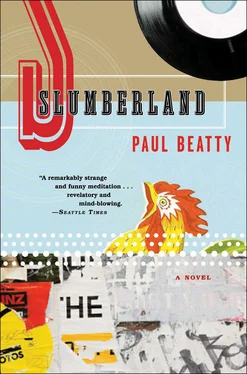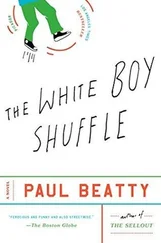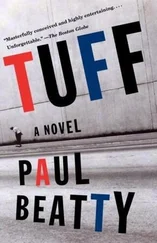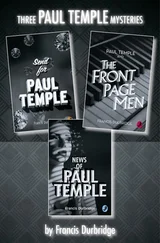Paul Beatty - Slumberland
Здесь есть возможность читать онлайн «Paul Beatty - Slumberland» весь текст электронной книги совершенно бесплатно (целиком полную версию без сокращений). В некоторых случаях можно слушать аудио, скачать через торрент в формате fb2 и присутствует краткое содержание. Год выпуска: 2009, Издательство: Bloomsbury USA, Жанр: Современная проза, на английском языке. Описание произведения, (предисловие) а так же отзывы посетителей доступны на портале библиотеки ЛибКат.
- Название:Slumberland
- Автор:
- Издательство:Bloomsbury USA
- Жанр:
- Год:2009
- ISBN:нет данных
- Рейтинг книги:4 / 5. Голосов: 1
-
Избранное:Добавить в избранное
- Отзывы:
-
Ваша оценка:
- 80
- 1
- 2
- 3
- 4
- 5
Slumberland: краткое содержание, описание и аннотация
Предлагаем к чтению аннотацию, описание, краткое содержание или предисловие (зависит от того, что написал сам автор книги «Slumberland»). Если вы не нашли необходимую информацию о книге — напишите в комментариях, мы постараемся отыскать её.
is laugh-out-loud funny and its wit and satire can be burning…There are incredible moments of tenderness…Beatty is a kind of symphonic W. E. B. Du Bois.”—
Ferocious, bombastic, and hilarious,
is vintage Paul Beatty and belongs on the shelf next to Jonathan Lethem, Colson Whitehead, and Junot Diaz. In this widely praised novel of race, identity, and underground music, DJ Darky has created the perfect beat. Now, he must seek out Charles Stone, a little known avant-garde jazzman, who can help bring his sonic masterpiece to fruition.
Slumberland — читать онлайн бесплатно полную книгу (весь текст) целиком
Ниже представлен текст книги, разбитый по страницам. Система сохранения места последней прочитанной страницы, позволяет с удобством читать онлайн бесплатно книгу «Slumberland», без необходимости каждый раз заново искать на чём Вы остановились. Поставьте закладку, и сможете в любой момент перейти на страницу, на которой закончили чтение.
Интервал:
Закладка:
“Herr Stone?”
The Schwa stood, hat in hand, except that he didn’t have a hat.
“Do you mind, Herr Gleibermann, if I see this gentleman first?” Our anonymous statesperson was smooth yet commanding. It was easy to see how he or possibly she carried North Rhine — Westphalia with 86 percent of the vote.
“Kein problem. .”
After the brass-handled doors clicked behind the Schwa, I asked a still-pale Klaudia what was the deal with his identity papers.
“What does Verfolgte des Naziregimes mean?”
Klaudia cupped her hands around my ear and whispered. Whenever she discussed matters referring to “the former East Germany,” she whispered. A survival instinct from the days when the walls had ears and best friends had microphones taped to their chests.
“ Verfolgte des Naziregimes means ‘persecuted by the Nazi regime.’ It was an identity the DDR gave to Holocaust survivors as recompense. Of course, in the government’s eyes the war was West Germany’s fault.”
“How so?”
“We were good, innocent Communists, and don’t forget, the Nazis hated Communists. My history teacher used to say, ‘Re-member, class, they gassed Communists alongside the Jews, and if you were a Jewish Communist, forget about it, they gassed and burned you twice just to make sure.’
“Anyway,” Klaudia continued, “if you have this Verfolgte des Naziregimes, you got party favors. .”
I grinned, picturing a bunch of survivors in conical paper hats, tossing confetti and blowing paper whistles, celebrating life, but she meant special privileges. “They could start a little private business, sell food or umbrellas, open up a bicycle-repair shop, even though any kind of open capitalism was strictly forbidden. Maybe they got a little stipend. Maybe they only had to wait six years for a car, I don’t know. But anyone who carried this paper basically didn’t get fucked with.”
I never could figure out how the Schwa supported himself. Now I knew. I mean, so what if the guy basically defected to East Germany — what was the current German government going to do, leave an honorary Jewish black jazzman to die?
The Schwa exited the office with the politician’s arm around his shoulder, a substantial check, and written carte blanche to build his wall in any shape or form he saw fit so long as it didn’t obstruct traffic or violate any noise-pollution statutes.
Old Herr Gleibermann, clutching a paper certificate of victimization exactly like the Schwa’s, touched his hand and in a halting English asked, “What camp were you in, brother?”
“Camp?”
“Sachsenhausen? Buchenwald? Bergen-Belsen?”
“No. Never.”
“I thought maybe you were a survivor. Your eyes.”
“No, sorry.”
“No camp?”
“Stephen S. Wise Day Camp when I was a young’un, that’s about it.”
The old man took his joke in good humor and entered into the chancellor’s inner sanctum complaining that his neighbor’s dog was still barking at all hours of the night.
The East Side Gallery is a mural-covered remnant of the Berlin Wall that runs along the north bank of the river Spree between the Oberbaum Bridge and the Ostbahnhof train station. It’s a kilometer-long memorial that simultaneously tries to erase and preserve the Berlin Wall’s legacy. Knowing that in this case the art is the canvas, the best of the faded and peeling panels incorporate the Wall into their themes. Birgit Kinder’s three-dimensional Trabant sedan crashes the through the Wall to freedom. The artist Suku simply lists the Wall’s achievements on a concrete résumé.
Curriculum Vitae
1961 1962 1963 1964
1965 1966 1967 1968 1969 1970 1971
1972 1973 1974 1975 1976 1977 1978 1979
1980 1981 1982 1983 1984 1985 1986 1987
1988 1989 1990
The last two entries are painted in a screaming red and caution-ary yellow, respectively.
It was here, nailed into the butt end of the Gallery, that the cornerstone of the new Berlin Wall, Fatima’s melted boom box, was laid. In many ways our wall was an extension of the Gallery — but one immune to the neglect and the countless coats of graffiti defacement that in recent years had rendered the original artwork almost invisible.
With the Schwa who knows where, Lars, Doris, and Klaudia gave me the honor of turning on the old radio, which had been hollowed out and stuffed with Fatima’s ashes and new electronic gadgetry. It buzzed with an antiphonary static that carried about thirty meters into the middle of the wide sidewalk.
The sound cut right through Klaudia.
“Was ist los?”
“This is freaking me out. I just realized what we’re doing.”
She removed a small radio from her satchel and fiddled with the power button. The red light flashed off and on.
“The sound makes the Wall more real.”
“More real than the gallery?”
“In a way, yeah. For you guys the murals are a kitschy tourist attraction, but for me, sometimes I walk past them and remember things.”
“You’re saying we’re trivializing the repression?”
I looked up and down Mühlenstrasse. It was getting harder to tell the differences between East and West. Back in the day it was easy. Border streets such as Mühlenstrasse were like the river Styx. Concrete tributaries not to be crossed because on the other side was Hades, a backward underworld where the living dead lived in prefab housing. I dashed across the six-lane street and tried to imagine what West Berlin looked like from an Eastern vantage point. People died attempting to cross that street, so I supposed it looked like the Elysian Fields: still part of the underworld, only the markets carried bananas.
“You’re forgetting the chicken-fucking song,” I said, somewhat out of breath from the return sprint. “The guy takes an improbable bestial coupling, like man and fowl, and makes it seem like you’re watching the secret bedroom tapes of Humphrey Bogart and Lauren Bacall. Whatever his reasons, it’s impossible for his music to trivialize anything. His music is an honorific to life — the good, bad, and the ambiguous.”
“There’s no denying the chicken-fucking song,” Doris said, her voice inflected with a sexual nostalgia I thought Klaudia might take offense to. She didn’t. Instead she erased any apprehensions we had with an ironic memory of totalitarian life.
She held out the radio.
“See this power button? In East Germany we didn’t have power buttons. The word ‘power’ was too aggressive.”
“That’s hilarious.”
“We had the ‘Netz’ button.”
“What does that mean?”
“It’s like ‘network.’ So when you turned on the television or whatever, you were plugged into the people. Everybody was sharing the power.”
“That’s deep.”
Klaudia handed me the radio.
“Here.”
There was a little bit of resignation in her voice that I took for the residue of thought control.
“What now?”
“There’s no place to put it.”
She was right. We were standing on the only thirty-meter stretch of Berlin sidewalk without trees. The closest thing we had to a tree was a street-lamp stanchion. A truck zipped passed us, illuminating our dumbfounded faces in bright xenon light.
The plan was simple. For the most part the old Wall ran along existing streets. Berlin is easily one of the most tree-lined cities in the world, so we’d stick satellite radios in the trees, where they’d dangle from the branches like transistorized fruit. In the treeless places where the Wall’s footprint had been erased by progress in the form of condominiums or vacant lots that would soon be turned into condos, there was no shortage of local artists who were willing to fill in the blanks. For instance, Steffi Rödl strung a clothesline made of barbed wire across the trash-strewn vacant lot that sat behind a row of apartment houses on Stallschreiberstrasse. Using wooden clothespins, she hung a twelve-foot-high curtain of shiny charcoal-gray silk that billowed majestically in the wind, a brilliantine representation of the Berlin Wall aired out like so much dirty laundry. In Potsdamer Platz, where the Wall had been eradicated by commercialism and skyscrapers, in lieu of radios — which would never have been heard over the din of downtown traffic — Michael Harnisch projected a musical stave across the white limestone base of the Sony Center. A computer instantly annotated the music and projected the notes onto the wall, the concert’s score running through downtown Berlin like a ticker tape opera. Using the Brandenburg Gate as a backdrop, Uwe Okulaja lined up a bank of high-powered green and red lights that, like a giant equalizer, shot a pulsing LED readout 250 meters into the night sky. There were other installations: a dancing fountain, an oscilloscope, and pushcarts where you could rent a set of those chintzy museum headphones and take a sonic tour of the new Berlin Wall; of course, none of these things would mean much if we couldn’t find somewhere to place the second speaker. It’d be like the Union Pacific and the Central Pacific coming up a few tracks short at the joining of the first transcontinental railroad. Some top-hatted CEO pocketing the golden spike with a “Fuck it, that’s close enough” shrug.
Читать дальшеИнтервал:
Закладка:
Похожие книги на «Slumberland»
Представляем Вашему вниманию похожие книги на «Slumberland» списком для выбора. Мы отобрали схожую по названию и смыслу литературу в надежде предоставить читателям больше вариантов отыскать новые, интересные, ещё непрочитанные произведения.
Обсуждение, отзывы о книге «Slumberland» и просто собственные мнения читателей. Оставьте ваши комментарии, напишите, что Вы думаете о произведении, его смысле или главных героях. Укажите что конкретно понравилось, а что нет, и почему Вы так считаете.












